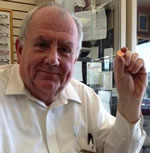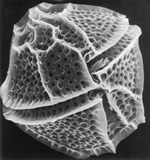Though he never became president, Alexander Hamilton was one of the most influential—and controversial—of America’s founding fathers.
From his humble origins as an
illegitimate child in the British West Indies to his famously untimely
death, here are a few facts about the legendary politician that might
surprise you.
 1. Like many of today’s celebrities, Alexander Hamilton probably lied about his age.
1. Like many of today’s celebrities, Alexander Hamilton probably lied about his age.
The illegitimate son of a Scottish immigrant father and a British West
Indian mother (who happened to be married to someone else), Alexander
Hamilton was born on the Caribbean island of Nevis on January 11.
Hamilton himself claimed that he had been born in 1757, but official
documents from Nevis list the year as 1755. Debate over this discrepancy
has continued for more than two centuries, but most modern scholars
agree that Hamilton likely changed his birth year intentionally. Shortly
after Hamilton came into the world, his father James abandoned the
family, fearful that the mother of his child would be charged with
bigamy. In 1768, when Hamilton was likely 13 years old, his mother died,
effectively leaving him an orphan. Shaving two years off his age would
have made him a more desirable candidate for an apprenticeship to a
local businessman. If this was Hamilton’s intent, it worked: He was soon
hired by an import-export firm and quickly impressed his bosses. In
1772 they decided to send Hamilton to the American colonies to further
his education. Arriving in his new home at the self-declared age of 15
and quickly diving into the political arena, Hamilton kept up the ruse,
and his perceived precociousness only enhanced his reputation as a
political prodigy.
2. Alexander Hamilton accomplished a lot—probably more than most people realize.
Though he never attained the highest office of his adopted country, few
of America’s founders influenced its political system more than
Alexander Hamilton. He was a member of the Continental Congress, an
author of the Federalist Papers, a champion of the Constitution and the
first secretary of the Treasury. But there’s so much more to Hamilton’s
legacy. While serving in the Treasury, Hamilton helped found the first
national bank, the U.S. Mint and the Revenue Cutter Service, a tax
collection bureau that would later become the U.S. Coast Guard. So
deeply involved in the development of the Cutter Service was Hamilton
that the original naval communication guidebook he devised was still in
use in 1962, during the Cuban Missile Crisis. A strong proponent of
manufacturing in the new nation, Hamilton and a series of private
investors created the Society for the Establishment of Useful
Manufactures, which developed one of the first industrial centers in the
United States, located in Paterson, New Jersey. In 1784 he founded the
Bank of New York, America’s oldest continuous banking organization. And
just seven years later Hamilton started a daily broadsheet—then known as
the New-York Evening Post—that grew into one of the country’s most
successful papers: the New York Post.
3. Alexander Hamilton was the subject of one of America’s first highly publicized political sex scandals.
In 1791 the married Hamilton met a young Philadelphia woman named Maria
Reynolds, who claimed she needed cash because her husband had left her
with a small daughter to support. Himself an orphan, Hamilton quickly
agreed, but their financial arrangement soon morphed into a trickier
entanglement as the pair embarked on an affair that would last more than
three years. Maria Reynolds was no desperate housewife, however. She
and her husband, James, had carefully planned the affair in an attempt
to extort even larger amounts from then-Secretary Hamilton, who readily
coughed up the sums. After James Reynolds was implicated in another
financial scandal, he informed investigators—a group that included James
Monroe and Frederick Muhlenberg—that Hamilton had been using government
funds as hush money. When confronted with this, Hamilton admitted to
the affair, but he also insisted that he had used his own personal funds
to cover it up, even showing Monroe his love letters from Maria
Reynolds as proof. Satisfied that this was a private matter, Monroe and
Muhlenberg agreed not to expose Hamilton. However, Monroe gave the
letters to his close friend Thomas Jefferson, one of Hamilton’s fiercest
political enemies. Jefferson passed them on to publisher James
Callender, already notorious as the preeminent 19th-century peddler of
political gossip. In 1797 the scandal exploded after Callender printed
the Reynolds-Hamilton letters in his paper. Hamilton, more concerned
with how the allegations of misuse of public funds would hurt him
politically than how the news would affect his family, went on the
offensive. He published his own lengthy pamphlet in which he
acknowledged the extramarital relationship. Hamilton was publicly
applauded for his honesty, but his political career was effectively
destroyed.
4. Alexander Hamilton and his eldest son were killed under similar circumstances and in the same location.
On July 11, 1804, Alexander Hamilton was shot and mortally wounded by
Vice President Aaron Burr in one of the most famous duels in American
history. Though this was Hamilton’s first—and last—duel, he was
certainly no stranger to the practice. One of the most divisive and
combative figures of his age, he had already been challenged to nearly a
dozen duels during his life, but each time he had managed to avoid
violence. His eldest son Philip, however, was not so lucky. In 1801,
after witnessing a speech denouncing his father, 19-year-old Philip
confronted New York lawyer George Eacker and demanded a retraction. When
Eacker refused, a duel was set for November 20 in Weehawken, New
Jersey. Eacker escaped unscathed, but Philip died an agonizing death the
following day. The loss devastated the Hamilton family, and many
historians believe it led to Hamilton’s own reluctance to fire directly
at Aaron Burr during their legendary duel just three years later.
Whatever his intentions, Hamilton missed his opponent but was promptly
shot in the stomach; he died the next afternoon.
5. It took more than 200 years—and two moves—to finally establish a proper monument to Alexander Hamilton.
Alexander Hamilton came to New York in 1772, and—with the exception of
stints in the military and government—the city would remain his home for
the rest of his life. In fact, Hamilton did more to promote and
champion the interests of New York than any other founding father. For
many years he and his growing family (there would be eight children in
all) lived in a series of rented homes in lower Manhattan. After
retiring from government service in 1795, Hamilton purchased a 32-acre
parcel of land in modern-day Harlem, which was then considered a rural
suburb of New York. He named it “the Grange” in honor of his father’s
ancestral home in Scotland. The house was completed in 1802—nearly
bankrupting the family in the process—and was the only home Hamilton
ever owned. The fate of the Grange in the years following Hamilton’s
1804 death took some surprising turns—literally. In 1889 the house was
donated to a New York church on the condition that it be moved from its
original location to a new plot 250 feet away. In the 1960s, after it
fell into severe disrepair, it was placed under the control of the
National Park Service, which was tasked with finding a suitable location
for the house and restoring it to its former glory. Because of steep
budget cuts and the objections of community groups, it took almost 30
years to fulfill this pledge. In 2008, more than 200 years after
Hamilton’s death, the Grange was placed on hydraulic lifts and
successfully relocated to nearby St. Nicholas Park—land that is now
city-owned but once fell within the original 32-acre Hamilton estate. In
September 2011, following a $14.5 million facelift, it reopened to the
public.













 Could
Detroit, which has the unenviable title of one of America's
Most Miserable Cities, get back its mojo by becoming ... a farm?!
Could
Detroit, which has the unenviable title of one of America's
Most Miserable Cities, get back its mojo by becoming ... a farm?!

 A 16-year-old was walking down a Corpus Christi, Texas street when he
accidentally bumped into a man who responded by biting the boy on the
neck. Then he
A 16-year-old was walking down a Corpus Christi, Texas street when he
accidentally bumped into a man who responded by biting the boy on the
neck. Then he 









 Poetry
doesn't usually come to mind when talking about science, but Maria Popova
of Brain Pickings came across what is considered the first poem ever published
in a strictly scientific journal.
Poetry
doesn't usually come to mind when talking about science, but Maria Popova
of Brain Pickings came across what is considered the first poem ever published
in a strictly scientific journal.
